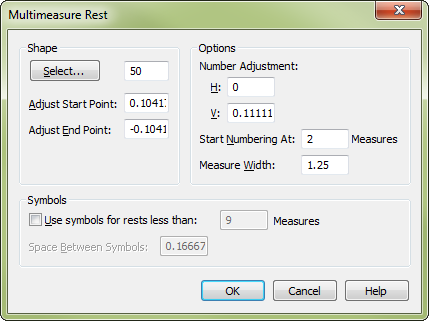

How to get there
- Choose the Measure tool
 .
. - Select a multimeasure rest in Page View, then choose Edit > Multimeasure Rests.
- Click Edit.
Or,
- Choose the Staff tool
 .
. - In Scroll View, select one or more staff handles.
- Choose Document > Special Part Extraction.
What it does
Use the Multimeasure Rest dialog box to define how Finale displays an existing multimeasure rest. These settings are almost identical to those in Document Options - Multimeasure Rest. You can choose between using a shape or Finale’s alternate style of notation for multimeasure rests. The alternate method combines whole and double-whole rests to represent block rests of different lengths, commonly those of eight or less measures. To set the default measurement units used in this dialog box, choose
- Select. The shape for the multimeasure rest itself is identified by the number in the text box next to the Select button. If a number other than zero appears in the text box, a rest has already been selected. If a zero appears in the text box, click Select to enter the Shape Selection dialog box, which contains the shapes available in this file. Click Select if you want to select an existing rest shape. If you want to create your own shape, click Create in the Shape Selection dialog box to enter the Shape Designer.
- Adjust Start Point • Adjust End Point. Use these values to adjust the start and end points of the shape used for the multimeasure rest. Changing these values lengthens or shortens the shape. You usually won’t need to change these settings, but you may find them useful if you have a cautionary clef sign that appears in the multimeasure rest grouping. Enter positive values to shift the shape’s start or end point to the right; enter negative values to shift the start or end point to the left.
- Number Adjustment: H: • V:. Set the horizontal and vertical position of the rest number by entering valuesin the Number Adjustment fields. Enter a positive value in H: to move the number to the right. Enter a positive value in V: to raise the rest number higher on the staff.
- Select. The shape for the multimeasure rest itself is identified by the number in the text box next to the Select button. If a number other than zero appears in the text box, a rest has already been selected. If a zero appears in the text box, click Select to enter the Shape Selection dialog box, which contains the shapes available in this file. Click Select if you want to select an existing rest shape. If you want to create your own shape, click Create in the Shape Selection dialog box to enter the Shape Designer.
- Adjust Start Point • Adjust End Point. Use these values to adjust the start and end points of the shape used for the multimeasure rest. Changing these values lengthens or shortens the shape. You usually won’t need to change these settings, but you may find them useful if you have a cautionary clef sign that appears in the multimeasure rest grouping. Enter positive values to shift the shape’s start or end point to the right; enter negative values to shift the start or end point to the left.
- Number Adjustment: H: • V:. Set the horizontal and vertical position of the rest number by entering values in the Number Adjustment fields. Enter a positive value in H: to move the number to the right. Enter a positive value in V: to raise the rest number higher on the staff.
See also:

